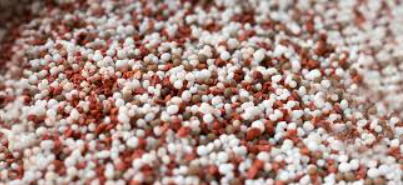The Future of Fertilizers: How Phosphates and Nitrates are Evolving (Part 2)
As agriculture evolves, innovative technologies are reshaping how fertilizers are produced, applied, and utilized. These advancements aim to boost efficiency, reduce environmental impact, and meet the growing demand for sustainable farming solutions.
Precision Agriculture Technologies
Precision agriculture harnesses cutting-edge tools like the Internet of Things (IoT), Artificial Intelligence (AI), and GPS to optimize nutrient application. These technologies allow farmers to monitor soil conditions, crop health and nutrient levels in real-time, ensuring that fertilizers are applied precisely where and when they are needed.
GPS-guided fertilizer application systems, for instance, enable farmers to map fields accurately and adjust application rates to match specific soil and crop requirements. This targeted approach minimizes nutrient waste, reduces costs and lowers the risk of fertilizer runoff, contributing to a more sustainable farming ecosystem.
Real-world examples include farms utilizing smart irrigation systems integrated with IoT sensors to monitor soil moisture and nutrient levels. AI-driven platforms analyze this data, providing actionable insights for efficient fertilizer management. Such advancements not only improve yields but also align with global sustainability goals, making precision future agricultural practices a cornerstone of a fertilizer’s development.
CRISPR and Genetic Engineering
CRISPR and other genetic engineering technologies are revolutionizing agriculture by enabling scientists to develop crops optimized for efficient phosphate and nitrate use. Through targeted genetic modifications, researchers can enhance plants’ ability to absorb nutrients from the soil, reducing the need for synthetic fertilizers.
For example, scientists have engineered crops with enhanced root systems that can access phosphorus in less soluble forms or thrive in low-phosphorus soils. Similarly, nitrogen-efficient crops are being developed to require less nitrate-based fertilizer while maintaining high productivity. These innovations hold immense promise for reducing the environmental impact of traditional fertilizers and addressing resource scarcity.
However, the adoption of genetically modified crops comes with challenges and ethical considerations. Public concerns about the safety of genetically modified organisms (GMOs), regulatory hurdles, and the need for equitable access to these technologies in developing regions are significant issues.
Despite these challenges, CRISPR and genetic engineering offer transformative potential for agriculture. By enabling crops to maximize nutrient use efficiency, these technologies are driving the development of sustainable farming systems that can support global food security while preserving the environment.
Sustainability and Policy Changes Shaping the Future
Global sustainability goals are driving transformative changes in the fertilizer industry, encouraging the adoption of eco-friendly practices and innovations. With the growing urgency to address climate change and environmental degradation, governments and organizations worldwide are implementing policies to promote sustainable agriculture and reduce the dependence on traditional fertilizers.
The United Nations’ Sustainable Development Goals (SDGs), particularly those focused on zero hunger, clean water and responsible consumption, have placed significant emphasis on minimizing the environmental impact of farming. These goals encourage reducing fertilizer overuse, preventing runoff into waterways, and promoting sustainable nutrient management practices. As a result, the industry is seeing a shift toward fertilizers that align with these objectives, such as bio-based and enhanced-efficiency fertilizers.
In addition to global frameworks, policies at the national and regional levels are shaping the future of fertilizers. Many governments are banning or restricting harmful chemicals, such as phosphates that contribute to eutrophication, while incentivizing the use of eco-friendly alternatives. For instance, subsidies and tax benefits for farmers adopting sustainable agriculture initiatives, like precision fertilization or organic farming, are becoming more common.
Farmers are also encouraged to embrace innovative practices through grants for technology adoption, such as IoT-enabled precision systems that optimize fertilizer use. These measures not only reduce environmental impact but also lower costs for farmers, creating a win-win scenario.
With increasing global attention on
eco-friendly fertilizer policies, the future of fertilizers is being shaped by a combination of innovation, regulation, and financial incentives. These efforts aim to balance the need for high agricultural productivity with the responsibility to protect the environment and ensure long-term sustainability for future generations.

FAQs: Addressing Common Questions About Fertilizer Trends
What are the main environmental challenges of using phosphates and nitrates?
The primary environmental challenges stem from
fertilizer runoff, where excess phosphates and nitrates leach into waterways, contributing to
eutrophication - a process that causes harmful algae blooms, oxygen depletion, and fish kills. Additionally, overuse of these nutrients can degrade soil health, disrupt local ecosystems, and lead to water pollution, posing risks to both human and environmental health.
Are organic fertilizers as effective as synthetic ones?
Organic fertilizers, such as manure and compost, are highly beneficial for improving soil health and fostering long-term fertility. However, they typically release nutrients more slowly than synthetic fertilizers, which may result in slower plant growth and potentially lower yields in the short term. While organic fertilizers are crucial for sustainable farming, they may need to be used in larger quantities to achieve the same immediate results as synthetic alternatives.
How will smart technologies impact small-scale farmers?
Smart technologies, including precision agriculture tools like IoT sensors and AI-driven platforms, offer small-scale farmers the ability to optimize fertilizer use efficiently. These technologies reduce waste, minimize costs, and increase yields, making sustainable practices more accessible and affordable. Over time, these innovations can help small-scale farmers stay competitive while promoting environmental stewardship.
What role does CRISPR play in improving fertilizers?
CRISPR and other genetic modification technologies enable the development of crops that require fewer fertilizers by enhancing nutrient absorption efficiency. For example, CRISPR can create plants with better phosphorus and nitrogen uptake capabilities, reducing the need for synthetic fertilizers and promoting more sustainable farming practices.
Conclusion: Paving the Way for a Greener Future
Fertilizers play an indispensable role in ensuring global food security by supporting healthy crop growth. However, as agricultural demands grow, it’s crucial to prioritize innovation and sustainability in fertilizer practices. Advancements in phosphates, nitrates, and sustainable technologies offer promising solutions to reduce environmental impact and optimize nutrient use. Companies like
Decachem are leading the way by producing high-quality phosphates and nitrates, contributing to more efficient and sustainable agricultural solutions. To secure a greener future for agriculture, industries, governments, and individuals must collectively embrace eco-friendly practices, invest in research, and adopt smarter, more
sustainable farming methods. Together, we can pave the way for a healthier planet and a more resilient agricultural system.
















